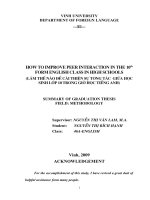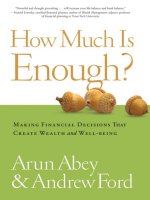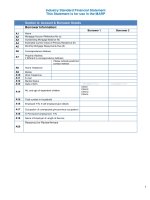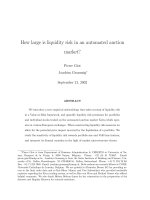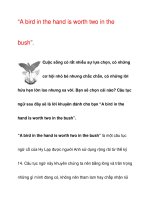How much is that hoagie in the window
Bạn đang xem bản rút gọn của tài liệu. Xem và tải ngay bản đầy đủ của tài liệu tại đây (168.74 KB, 41 trang )
How much is that hoagie in the
window?
Student Objectives:
• Define the term food cost
• Perform simple percentage food cost calculations
• Define the term formula pricing
• Describe the term product specification and relate its
role in maintaining food cost
• Define the term minimum standard
• Define the term par stock and describe how it is
related to food cost
• Define the term portion control and discuss how to
implement effective portion control
• Define physical inventory and describe its importance
in controlling and defining food cost
• Demonstrate the ability to calculate food cost and
percentage food cost
I. What is food cost? Food cost is the cost
of food prepared for and consumed by the
customer. In a broader sense, it is part of
The Cost of Sales which refers to the cost of
all products, both food and beverage,
consumed by the guest.
A. Food costs are traditionally expressed in
both dollar amounts and as a percentage of
sales. For example, if your operation’s
monthly sales were $75,000 and your food
costs were $25,000, what would your
percent food cost be for that month? (33.3).
B. Actual food cost dollars are essential to keep
track of, but food cost is a variable expense that
rises and falls with the volume of sales
(i.e., its size is relative to the volume of sales). A
percentage food cost can be a reliable indicator of
performance and should remain consistent
regardless of sales volume.
C. There is no “magic number” when it comes to
food cost percentage.
Percentage food costs are what your operation
decides for them to be.
Your operation’s targeted food cost will vary
depending on the market segment you serve,
your volume of business, fixed expenses and
overhead, other variable costs, desired profit and
your sales and pricing strategies.
D. Percentage food costs are valuable to the
foodservice manager because
–
they can readily be compared to previous reporting
periods, budgets and industry averages for operations
that fall into similar categories (i.e. quick-serve Mexican
restaurants in central Texas with an annual sales
volume of $750,000 to $1,000,000). In this way the
manager can gather quick feedback for comparison and
can judge optimal performance.
II. Controlling food cost
The menu
– 1.
When costing and pricing the menu, each
individual item is not “formula priced” according to the
targeted food cost. If this was the case, given a 30%
targeted food cost, a glass of iced tea that costs your
operation
5 cents to produce would only sell for 20
cents.
A.
– Consequently, if your operation used formula pricing for
a shrimp cocktail that costs $5 to produce, your selling
price would be $20 (not a likely price point).
– Pricing strategies are designed to derive an average
food cost from all items on the menu and the frequency
of sales for each item in the menu’s product mix.
II. Controlling food cost
B. Purchasing
– 1.
Specifications (specs): All of the food,
beverages and supplies that your operation has
selected to meet certain minimum specifications
to ensure the quality and consistency your
customers have come to expect when they visit
your facility.
B. Purchasing
2. These specifications are in writing, and
will determine the cost of goods being
purchased from outside vendors.
B. Purchasing
3. Most operations put their product “specs”
out to bid or enter into a buying agreement
with a trusted, reputable vendor.
B. Purchasing
4. Prices may fluctuate with the seasonality of
items and other supply and demand situations.
Try to determine pending price fluctuations in
advance through discussions with your vendors
and apprise management of any pending price
changes.
B. Purchasing
5. Vendors adherence to minimum
specifications must be monitored with each
delivery.
B. Purchasing
6. Price is not always the determining
factor. Service, flexibility, consistency and
trustworthiness of the vendor must be taken
into consideration.
B. Purchasing
7. Sometimes food cost can actually be too
low. Remember that specifications are
carefully outlined in order to achieve
customer satisfaction and expectations. If
the purchasing agent compromises quality
for price, food cost may drop but so will your
customer base.
B. Purchasing
8. Most operations have a written code of
ethics for purchasing that forbids the
purchasing agent to receive any personal
compensation from suppliers, either in the
form of kickbacks or gifts.
C. Receiving and storage
1. Delivery times should be scheduled to meet
the needs of the operation. Trained personnel
must be present to check in, weigh, count and
examine each delivery at the time of delivery.
2. Discrepancies and/or rejected products must
be noted at the time of delivery.
3. Invoice prices must match those quoted on the
order form. Adjustments or credit memos should
be issued immediately.
4. Management should be notified about any
discrepancies, back-orders, out-of-stocks or
rejected product.
All perishable inventory should be rotated into
stock immediately upon
delivery.
6. All inventory should be dated upon receipt.
7. All storage facilities should be monitored regularly
for temperature and sound storage practices to
maintain maximum product quality, shelf life and
safety.
8. All products should be inventoried and accounted
for on a regular basis.
9. Minimum par levels should be established and
maintained to avoid over-and under ordering.
10. FIFO (first in, first out) stock rotation should be
practiced and monitored.
5.
D. Preparation
1. Food preparation staff should be issued only
the supplies needed for that day’s/shift work
needs.
Requisitions should be maintained for all goods
taken from storage for production, and these
requisitions should be logged.
2. Perpetual inventories should be taken on high
cost items (steaks, lobster tails, etc.) and matched
against sales and waste sheets.
3. A.P. to E.P. yield tests should be done
frequently.
4. Portion control procedures should be set in
place and carefully monitored.
D. Preparation
5. Waste sheets should be in place and
monitored.
6. Use small batch preparation and progressive
cooking principles.
7. Production schedules should be in place and
updated daily.
8. Production charts and carry-over foods need to
be logged and identified for immediate use.
9. Make sure scales are in place and portion
control is being followed.
10. Food preparation staff needs to be well trained.
E. Controlling inventory
1. Complete physical inventories should be taken
frequently.
2. Most foodservice operations take inventory at
least twice a month.
3. The end-of-month (EOM) inventory reflects the
end of an accounting
period and is the inventory that is entered into
the monthly profit and loss
statement (a.k.a. financial statement); other
inventories are for proactive
control by management.
E. Controlling inventory
4. All food items are entered into a record and
that record is extended to reflect the aspurchased value of all food items. (A similar
inventory is taken for all products related to
alcoholic beverage service.)
E. Controlling inventory
5. Physical inventory sheets should be
designed to be taken shelf-to-sheet.
6. This value of the closing inventory is then
used with the food revenues for
the same time period to determine the
cost of goods sold (C.O.G.S., or
food cost).
E. Controlling inventory
7. The dollar value of closing inventory of any
given accounting period is
also the value of the opening inventory for the
next accounting period.
8. The formula for determining food or beverage
cost is expressed as follows:
Opening Inventory + Purchases =
Total Available - Ending Inventory =
Cost of Food
E. Controlling inventory
9. A useful mnemonic tool for the student to recall this formula is
“OPEC”. Example:
Grey Goose Café Month Ending 05/30/2001
Cost of Food
Opening Inventory
$2,000
+ Purchases
$6,000
= Total Available
$8,000
- Ending Inventory
$3,000
= Cost of Food
$5,000
Cost of Food/Revenue = %
$5,000/$18,000 = 28%
Budgeted Cost = 30%
Actual =
28%
Variance = 2%
